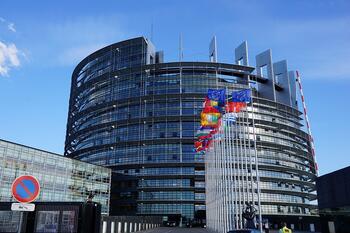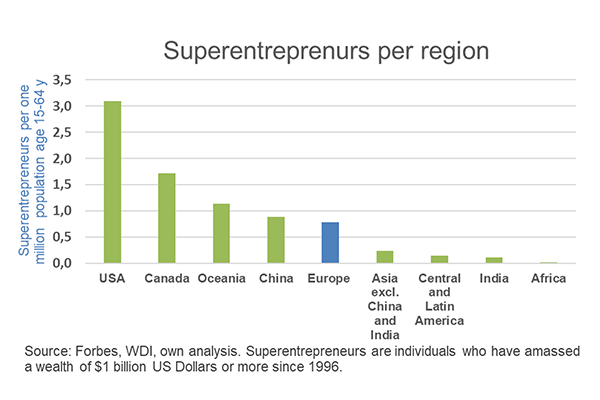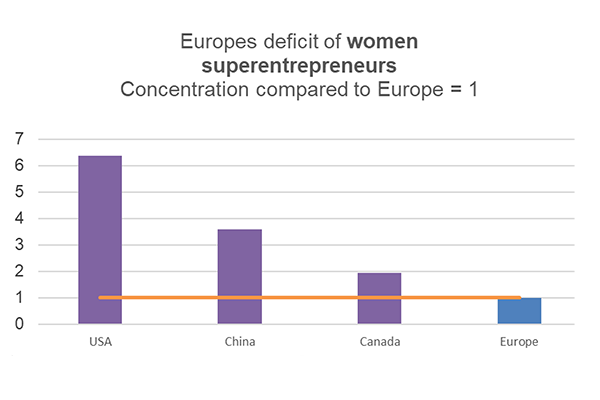
When mapping the concentration of superentrepreneurs in the world, we find a paradox in Europe. Half of the top-ten countries with the most superentrepreneurs are found in Europe, yet Europe is far behind the US and Canada when it comes to high-end entrepreneurship. Another perhaps surprising fact is that gender equal Europe has a particularly strong deficit of women superentrepreneurs.
In the world of today, there is a need to create value through business growth, rather than financial engineering. The superentrepreneurs project is about studying high-end entrepreneurship and focuses on the close to 2 500 individuals in the world who have built up billion-dollar fortunes, by creating new companies or growing small businesses into large successful ventures. The point is mainly to measure the tip of the iceberg; by looking at superentrepreneurs, we can understand which countries are more conducive to free enterprise in general.
Switzerland, a knowledge-intensive economy with business-friendly regulation overall, has more than four superentrepreneurs per million adults, the second highest rate in the world after Singapore. Cyprus, with a favourable tax system, ranks third, slightly above the US which has the fourth highest concentration of superentrepreneurs in the world. Sweden, a leading country in Europe in terms of research and development investments, has the sixth-highest concentration of high-end entrepreneurs.
| Countries with the highest concentration of superentrepreneurs per capita Based on comparison of all countries with at least one million inhabitants |
|||
| Total superentrepreneurs per million 15-64 year old population, both sexes |
|||
| 1 | Singapore | 4.7 | |
| 2 | Switzerland | 4.1 | |
| 3 | Cyprus | 3.6 | |
| 4 | USA | 3.1 | |
| 5 | Israel | 2.6 | |
| 6 | Sweden | 2.0 | |
| 7 | Ireland | 1.9 | |
| 8 | Australia | 1.8 | |
| 9 | UK | 1.8 | |
| 10 | Canada | 1.7 | |
Ireland, which has a rapidly growing tech-sector, ranks on seventh place, followed by the UK on ninth place. Half of the countries on the top-ten list are located in Europe, but while some European countries have a high concentration of superentrepreneurs, in Europe as a whole there are only 0.8 superentrepreneurs per million adults. This is only a quarter of the 3.1 superentrepreneurs per capita found in the US, and half the level of Canada—even Oceania and China have a higher concentration than Europe.

The lack of superentrepreneurs reflects the fact that Europe still largely relies on old fortunes, rather than new ones created through new companies. European nations have historically progressed because they have been at the forefront of technology and new wealth creation, and while countries such as Sweden, Switzerland, and the UK still are at the forefront of technological development, the same cannot be said of all of Europe. A study by McKinsey & Company recently pointed to the fact that the US and China are dominating in fields of technology such as quantum computing and 5G, while Europe despite its strong science base and robust pool of talent is lagging in the technology race.
We find that in all regions of the world, most superentrepreneurs are men, with only one out of twenty billionaire entrepreneurs being women. Of the Chinese high-impact entrepreneurs, as much as 8 percent are women, while the level is 4 percent in the US and below 3 percent in Europe. China has three times more women superentrepreneurs, per capita, compared to Europe, while the US has six times as many.

The lack of women amongst European high-impact entrepreneurs is in part because education, health, and elderly care in European systems are limited by public sector oligopolies and regulations. In Europe, women-dominated parts of the economy, therefore, offer limited opportunities for high-impact entrepreneurship. The US as well as Asian economies such as China are more open to entrepreneurship in health and education, which explains why otherwise gender equal Europe is so far behind in this regard.
European societies would benefit from fostering high-end entrepreneurship, as our global outlook shows a clear link between superentrepreneurs per capita and the level of unemployment. One more superentrepreneur per million adult inhabitants is linked to 0.88 percentage points lower unemployment. The effect is strongest for the broad middle class with intermediate education, for whom one more superentrepreneur per million adults is linked to 1.1 percentage points lower unemployment.

There are several policy factors that are positively correlated with a higher share of superentrepreneurs: stronger property rights protection, ease of doing business, lower profit taxes, and lower capital gains taxes, are all positively linked to the rate of superentrepreneurs. There is also a link between strong performance in schools, as measured by the international PISA study, and the share of high-end entrepreneurs. The European entrepreneurial paradox exists because conditions for high-end entrepreneurship are good in a few countries, such as Sweden and the UK, but are lacking in Europe as a whole.
European decision-makers should make it a priority to encourage entrepreneurship in general and remove barriers to entrepreneurship in women-dominated fields of the economy, such as education, health, and elderly care. In the long-term, Europe cannot remain a world leader in technology and prosperity, without also boosting entrepreneurship. To compete with China and the US in the global race of technology and business, European nations need to boost research and development spending, and continue the process of market integration.
Authors:
Nima Sanandaji, Director European Centre for Entrepreneurship and Policy Reform
Klas Tikkanen, Chief Operating Officer Nordic Capital
Kristoffer Melinder, Managing Partner Nordic Capital
| Attachment | Size |
|---|---|
| entrepreneurs-2022_01.png | 55.19 KB |
| entrepreneurs-2022_02.png | 28.32 KB |
| entrepreneurs-2022_03.png | 85.53 KB |












